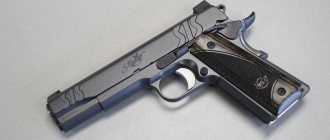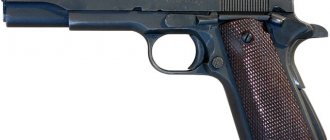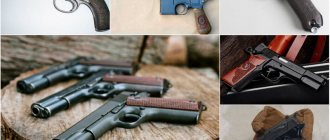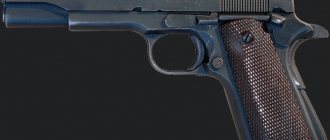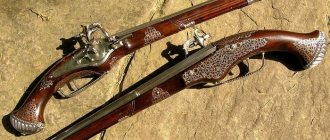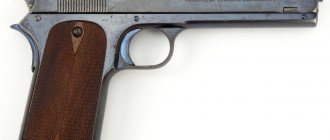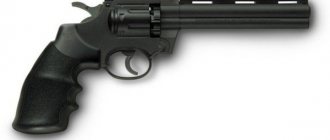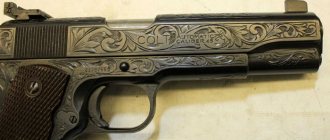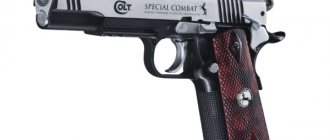Home | Weapons | Pistols | USA | Colt M1911A1
Colt M1911A1 pistol from 1943
In 1926, in order to improve the performance and reliability of the M1911 pistol, a small modernization was carried out: the length of the trigger was reduced, and a notch appeared on its front surface; the shape of the trigger spoke has been changed; chamfers have appeared at the base of the handle, in front of the trigger, for better access to it; the rear protrusion of the automatic safety lever has been increased; the rear surface of the handle (mainspring case) received a curved shape; the front sight and rear sight slot are made wider; the firing pin has been strengthened. Since 1940, the walnut cheeks of the handle were replaced with plastic ones. The upgraded version was named M1911A1. In addition to Colt, M1911A1 pistols were also produced by Remington-Rand, Ithaca Gun Company, Union Switch and Signal Co. and Singer Sewing Machine Co.
During World War II, this pistol was used in the US Army by officers and non-commissioned officers, the Air Force, Marine Corps, special and technical troops, and was also supplied to Great Britain, France and the USSR. In Great Britain, the Colt 1911 pistol was in service with the Royal Navy and the Royal Air Force. Captured pistols were also used by the German army. In the Wehrmacht, Colt 1911 pistols were in service as a limited standard weapon under the designation Pistole 660 (a). 45-caliber Colts were widely popular in the armies of all warring parties and had a well-deserved reputation as an effective and reliable military weapon. The next wars in which the Colt M1911 A1 was used were Korea and Vietnam, and later a variety of local armed conflicts around the world.
Military operations in the Pacific Islands
The Colt 1911 automatic operates according to the scheme of using recoil with a short barrel stroke. The coupling of the barrel with the bolt-casing is carried out using two lugs of the breech of the barrel and the corresponding grooves of the bolt-casing. Disengagement is carried out by lowering the barrel, using an earring, pivotally connected to the barrel and frame, during rollback. The axis of the bolt stop lever is also the lower axis of the shackle. In the front part of the bolt casing there is a removable barrel bushing that holds the muzzle of the barrel. The return spring is located under the barrel. The trigger mechanism is hammer type, single action, with safety cocking. The trigger moves longitudinally in the pistol frame. It is connected to the sear by two symmetrical rods located on the sides of the magazine shaft in the handle of the Colt 1911 pistol.
The design of the trigger has a disconnector that prevents firing a shot when the bolt is not completely closed. On the left side of the frame there is a safety lever, a bolt stop lever and a magazine latch. At the rear of the handle there is an automatic handle safety lever that blocks the trigger pull and turns off only when the handle is grasped. The rear surface of the lower part of the handle is formed by the mainspring canister and has a curved shape in the Colt M1911A1 model. The safety lever blocks the cocked hammer and the bolt casing. The closed-type ejector is located inside the shutter-casing. The box-shaped single-stack magazine holds 7 rounds. Burnishing or phosphating was used as a coating. The grip cheeks of the Colt 1911 were initially made of walnut, but since 1940 they have been replaced with plastic.
Colt M1911A1 pistol from 1941
In the 1950s In the United States, the popularization of the Colt 1911 pistol as a weapon for self-defense and sport shooting was facilitated by a number of articles by the famous American shooter Jeff Cooper, which described the advantages of this weapon. Soon the police also noticed them. Departments that used low-power .38-caliber revolvers adopted Colt self-loading pistols chambered for 45-caliber ACP. With the advent in the 1960-1970s of pistols using the 9mm Parabellum cartridge, equipped with a double-action trigger and large-capacity magazines, the Colt M1911 began to be replaced by weapons from Smith & Wesson, Sig Sauer, Glock, Beretta and Ruger, but continued to be very popular among ordinary citizens as weapons for self-defense and practical shooting.
However, the small magazine capacity and lack of self-cocking caused the Colt M1911A1 to be removed from service in 1985. Instead of the old Browning pistol, the US armed forces adopted the Beretta 92FS, under the designation M9, and the Sig Sauer P228, under the designation M11, 9-mm caliber, having high-capacity magazines, a double-action trigger, less recoil force, as well as smaller dimensions and weight ( Sig Sauer P228). Thus, the Colt M1911 and M1911A1 pistols were in service for 74 years, and more than 2.5 million of them were produced. The rearmament of the US Army with new pistols was not completed by the time Operation Desert Storm began, as a result of which Colt M1911A1s were used in Iraq by units that did not have time to rearm. In difficult operating conditions, they once again confirmed their best qualities, while the M9 often experienced delays when firing. Currently, the Colt 1911 is still in service with some units of the US Army and Marine Corps. Marine Force Recon, SWAT, FBI Hostage Rescue Team and 1st Special Forces Operational Detachment-Delta (better known as Delta Force) use various modern versions of the Colt 1911. One of the most famous military variants of the M1911 is the MEU(SOC) pistol, or officially "Pistol, Caliber .45, MEU(SOC)", based on the Springfield Armory sports model and used by reconnaissance battalions US Marine Corps - Force Recon (United States Marine Corps Force Reconnaissance).
Phosphated M1911A1 pistol manufactured in 1943
The Colt M1911A1 pistol has both strengths and weaknesses in its design. The disadvantage of the pistol is the difficulty of handling the weapon in the absence of constant training and the availability of appropriate skills, since safe carrying of a pistol, ready to immediately open fire, is only possible with the hammer cocked and the safety switch on. Due to the low initial speed and large mass, the bullet has a high flight trajectory, as a result of which the actual effective firing range does not exceed 25 meters. Disadvantages also include large dimensions and weight with a small magazine capacity, but they are minimized in modern versions of this pistol. The advantages are the high stopping power of the bullet of the cartridge used, reliability of operation, safety of handling and shooting accuracy.
Since 1961, Colt began producing limited editions of its pistols and revolvers, produced in honor of a particular historical event. This weapon was distinguished by a higher quality of processing of external and internal surfaces, more careful fitting of parts and inspection. In total, about forty series were produced with varying numbers of copies in each of them. The Colt M1911 was also produced in such limited editions. These are memorial pistols dedicated to the First and Second World Wars. Of course, such pistols are very rarely found even at famous arms auctions, but especially rare are the ones preserved in their original wooden boxes, with all the documents and certificates. The rarest options are “pairs” and “fours”. These pistols were produced in sets, with the same serial numbers and distinguished only by suffixes. This is a weapon of excellent quality and engraving craftsmanship, very beautiful, rare and valuable.
Pistol Colt M1911A1 Photo Ichiro Nagata
American soldier in Japanese-occupied China with an M1911A1
The use of the Colt 1911 pistol in some special forces units of Russia and the former USSR is little known. Supplied to the Soviet Union during World War II as military aid, the M1911A1 was not widely used by the Red Army due to a shortage of non-standard caliber ammunition. Most of these pistols remained in warehouses. But the high efficiency of fire, especially in comparison with the domestic PM, was the reason that a certain number of American pistols were withdrawn from warehouses and used along with other weapons in service and used in special units. The Colt 1911 .45 caliber was produced, improved, copied and used throughout much of the 20th century in various variations throughout the world. It is or was in service in more than twenty countries around the world. At the moment, weapons based on the M1911 family with various changes and design improvements are widely used in various US special forces, police, and are also very popular in the civilian weapons market. This is facilitated by such innovations in its design as a large-capacity magazine, an automatic firing pin safety and a feed ramp (cartridge guide or so-called “cracker”), designed for the use of any type of bullets, as well as only a self-cocking firing mechanism. As a result, the excellent design and the potential for modernization inherent in it, together with the latest improvements, contributed to the emergence of at the end of the 20th and beginning of the 21st centuries. many excellent combat pistols, for example, such as the Para-Ordnance with LDA trigger.
There are many legends about this pistol. Allegedly, its recoil is so great that an inexperienced shooter cannot even hit a target at 23 meters, that a bullet hitting a person throws him back a couple of meters, that it could be used to shoot down a Japanese Zero fighter... There are many similar legends, but none of this is true more than fiction. It is impossible to shoot a Zero or knock out a Tiger tank with a Colt M1911 pistol. His bullets do not knock a person down, otherwise the shooter himself would fly back according to Newton's law. It is true that a person most often falls down after being hit by a .45 caliber bullet because he is already dead or seriously injured. But this fall does not occur as a result of the transfer of kinetic energy from the bullet. It's elementary. Another myth is that the new Government should be immediately taken to a gunsmith to improve reliability. This weapon was designed to use jacketed bullet cartridges. And if a pistol is produced with a minimum of changes to the original design, then it will work perfectly with the appropriate cartridges. If the owner, of course, intends to use just such ammunition both for training and for self-defense.
Colt M1911A1 pistol manufactured in October 1944
Colt M1911A1 manufactured by Singer Manufacturing Company
One important clarification needs to be made here. 45-caliber jacketed bullets have proven to be very effective in real combat situations, quickly stopping the enemy in close combat. And this is without using expansion bullets. If the owner still wants to shoot with expansive cartridges, then there are many options on the market for the Colt 1911, optimized for reliable operation with such cartridges, that is, having extended chamber bevels with an optimal angle of inclination. So this imaginary problem can be solved very simply. Contrary to the misconception about heavy recoil, the M1911 is very comfortable to shoot and handles well even when firing high-speed +P rounds. Many shooters with small hands find the Colt M1911's grip more comfortable and the pistol more suitable for them than modern 9mm repeaters. The M1911 is one of the most enjoyable combat pistols in the world to shoot. The sharp, hand-punching recoil of compact light alloy revolvers chambered for the .357 Magnum cartridge is an indisputable fact. Mid-size 9mm pistols with alloy and polymer frames produce harsher recoil than the Colt M1911.
Here are a couple of episodes from the M1911A1's combat career. Sergeant Ernest Kuma, a tank commander from the 72nd Tank Battalion of the US Army, who took part in the Korean War, showed personal courage and courage, almost single-handedly, repelling a massive enemy attack with one tank. His tank was deployed to support infantry on the Naktong River. Around midnight on August 31, about 500 North Korean soldiers crossed the river and went on the offensive, inflicting heavy casualties on the American infantry. Sergeant Kuma discovered that his tank was the only obstacle in the enemy's path. Giving orders to his team, he remained in his position throughout the night, repelling more and more attacks. During one of these attacks, the enemy surrounded the tank and Kuma, taking hold of a 50-caliber machine gun mounted on the turret, began to personally repel the attack. When the ammunition ran out, Sergeant Kuma continued to fire with his Colt M1911A1 service pistol and throw grenades at the attackers. After nine hours of close combat with superior enemy forces, the sergeant withdrew his tank to safe positions occupied by American troops. During the retreat, he continued to inflict fire damage on the enemy and destroyed three machine gun emplacements. In total, Sergeant Kuma destroyed 250 enemy soldiers. His actions gave the infantry time to gain a foothold in defensive positions and prevent the enemy from breaking through the defenses. Wounded in battle and evacuated for treatment, Ernest Kuma asked to be returned to the front.
Commercial version of the Colt M1911A1 - Government Model pistol
Lieutenant Walt Hogan, along with six other pilots, was forced to spend the night in a tent near a hastily constructed airstrip on one of the Philippine islands. Several bounty hunters passed through the perimeter. The native tore down the awning and went inside brandishing the local equivalent of a machete. One of the pilots grabbed a .30 caliber M1 carbine and pumped two bullets into the attacker's chest. The aborigine did not even flinch, continuing to advance and grabbed one of the pilots, swinging his weapon. Then Walt Hogan, who by that time had managed to get his 45-caliber Colt 1911, took aim between the “hunter’s” eyes and fired. The bullet hit just above the attacker's right eye. He shuddered and immediately fell down as if knocked down. After this incident, the guy with the carbine traded it for a Colt 1911. Hogan kept both the machete and the pistol, which he just replaced the sights with and re-buffed. This weapon, which saved the life of its owner and his comrades, was inherited by the son of Walt Hogan, who carefully preserves the family heirloom.
The responses of Texas police officers to questions about the M1911 pistol are very revealing. Even in the United States, many, including police officers, do not consider the 45 caliber optimal for personal weapons, preferring the more compact 40 caliber pistols with a smaller grip and a larger magazine capacity, or 9 mm models. On the pages of the gun press and on Internet forums you can often see the question: “Why do you carry a Colt 45 caliber?” To which Texas law enforcement officers respond, for example: “Because they don’t make Colt .46 caliber!” Another controversial issue is carrying a loaded, cocked pistol, which some citizens feel is unnecessarily dangerous. For example, to a similar question, “Isn’t it dangerous to carry a pistol with the hammer cocked and a round in the chamber?”, a police officer, also from Texas, responded as follows: “I wouldn’t carry the son of a bitch if he weren’t dangerous.”
M1911A1 and Vietnam War-era M16A1 assault rifle
Tunnel Rats soldier with M1911A1 pistol, Vietnam War
History of creation
At the beginning of the 20th century, the American army faced the urgent question of replacing standard 38-caliber revolvers with something more powerful. The indirect impetus for this decision was the American-Philippine War of 1899. The stopping power of a .38 caliber bullet was not sufficient to instantly kill an enemy, and a dying enemy could hit a US soldier. Also, at the moment, revolvers had insufficient rate of fire and high-speed shooting accuracy.
In 1900, 1902 and 1905, designer John Moses Browning developed three versions of the pistols, but all were rejected due to the complexity of the design and subsequent maintenance. Finally, in 1911, the designer introduced an easy-to-use and maintain weapon that satisfied the selection committee and subsequently became the standard weapon of army and police officers, called the Colt Government M1911.
The weapon withstood serious tests - a series of one hundred shots at intervals of five minutes, after every thousand it was disassembled for cleaning, lubrication and critical inspection for damage. After firing six thousand shots, the pistol was fired with cartridges with specially deformed ammunition and cartridges with different masses of gunpowder. After this, the gun was immersed in various acids, immersed in mud and sand. At the end of all the tests, the selection committee highly appreciated the performance characteristics, reliability and ease of maintenance of the pistol.
In 1926, the first and largest modification of the pistol was made, called the Colt Government M1911A1 - in addition to modernizing the trigger mechanism, cuts were made on the pistol frame for a more comfortable grip, corrugation was added to the hammer and trigger, the disconnect button on the back of the handle was extended, and additional corrugation applied to the handle.
"Glock", just "Glock"
Austrian Gaston Glock has not picked up a firearm for half his life. He worked as an engineer, created garden brushes and dustpans, fastenings for cornices, and made field knives. Successfully worked with polymers. When he was already over 50, he heard that the army had announced a competition for a new pistol. Until the very end of the 1970s, Austrian officers were armed with the old Walter P38 - the Nazis still fought with it.
And what happened next was either a fairy tale or a fantasy: Gaston bought several pistols (Italian Beretta 92F, Swiss Sig Sauer 220, Czech CZ 75 and the aforementioned “Walter P38”), learned how to disassemble and assemble them. And I decided that I would create a much cooler trunk. I started with a wooden gun, then remembered my experience with polymers. Tested the prototype in my garage. I was very afraid that the pistol would break when fired, so, being right-handed, I shot with my left hand. So, if he mutilates his hand, at least not the right one.
But everything worked out.
Moreover, in just a year he created a pistol that won the competition. The pistol turned out to be amazing: light, powerful, accurate, convenient and at the same time inexpensive. Consisted of only 33 parts. He didn’t stop shooting after he was rolled in the mud, drowned in water, frozen to minus 50 and heated to plus 50. Almost like a Kalashnikov assault rifle.
In the early 1980s, the Glock 17 (the number “17” is the patent number) was purchased by the Austrian army in the amount of 30 thousand. Then Norway adopted it. Then. You could say almost the whole world. Even if it is not in service with any army, it is used by the police and intelligence services, and is present in shooting ranges.
Today, the fifth generation of Glocks is being produced: new springs, a different technology for cutting the barrel, ergonomic handles.
Last year, the Kalashnikov and Glock assault rifles were crossed in the United States. The result is an interesting AK-Draco NAK9 submachine gun - based on a Kalash, but with 33-round magazines from a Glock.
The Israelis have come up with a body kit that turns a pistol into a carbine with a comfortable butt. There are many changes, but the gun is essentially the same: an ingenious design created by a weapons amateur.
Gaston Glock, according to Forbes, is “worth” $1.1 billion. He has a young wife, two private jets, and a helicopter. His equestrian club includes Sharon Stone, Naomi Campbell, Jean-Claude Van Damme, Gerard Depardieu and Alain Delon.
And his Glocks are already fighting in a century that has not yet arrived. Virtually. In the Fallout video games, there is the character Gaston Glock: a cyborg whose artificial intelligence is based on the creation of Gaston Glock. Cyborg goes about his business: creating plasma pistols. Of course, Glock brand.
Device
The Colt 1911 is built according to the classic design for 45-caliber self-loading pistols - a short-stroke barrel and a semi-ring locking bolt
Pistol design
Colt M1911 consists of 53 parts. The main ones, accessible to the user, are the bolt casing, the barrel with the hinge link, the fastening sleeve, the spring stop, the bolt spring with the guide pin, the barrel delay lever, which serves as a barrel lock, the frame, the trigger mechanism and the magazine.
The trigger mechanism is single action, hammer type, with an open trigger. A cylindrical mainspring of a twisted shape is located immediately behind the magazine well, in the rear of the handle. The trigger and mainspring are connected by a trigger rod. The pistol slide contains a spring-loaded inertia-type firing pin.
The trigger mechanism includes: a trigger rod with a sear attached to it, a trigger connected to the trigger rod and moving forward (the so-called classic “trigger” trigger), a trigger spring and a vertically moving disconnector.
When fired, the bolt moves back, the disconnector moves down the handle, disconnecting the sear and the trigger rod. The integrity of the structure is restored by releasing the trigger, that is, by removing the finger from the hook. Also, the disconnector opens the mechanism before the bolt returns to its original position, eliminating the possibility of even an accidental shot if the barrel is not locked.
The design of the safety is noteworthy - it is not located on the bolt housing, as is common in many pistols, but on the frame, which allows you to intuitively switch the trigger lock, spending less time on the shot.
Principle of operation
The Colt M1911 uses a short-stroke reloading system. The length of the barrel stroke is approximately 8-10 millimeters, then the barrel is held by the barrel delay lever, and the bolt continues to move backward by inertia, extracting the cartridge case from the chamber with the extractor tooth and throwing it out the extractor window. After reaching maximum spring compression, the bolt housing begins to move forward, driving the cartridge from the magazine into the chamber, locking the bolt and returning the barrel to its place.
Thus, the possibility of the cartridge sticking into the chamber cut is eliminated, due to the location of the cartridge and the barrel on the same line.
Ammunition for Colt M1911
Initially, the pistol was developed for a standard 45 caliber cartridge, later called .45 ACP (cartridge for the Colt 45 caliber automatic pistol). This is a classic ammunition with a wafer brass case and a bullet weight of 14.9 grams.
Subsequently, the range of cartridges acceptable for use in the Colt M1911 expanded:
.45 ACP is the standard cartridge for firing against manpower and unarmored vehicles. Brass sleeve, a spherical-cylindrical bullet, with a lead alloy core and a brass or steel, copper-plated shell.
.45 M26, Tracer - a tracer bullet, in some cases it can be used as a signal or incendiary ammunition. A cartridge with a standard brass sleeve, the bullet itself is three-component, consisting of a cup with a tracer mixture, a core made of a lead alloy with antimony and a copper-plated steel or brass shell.
The .45 Ball Match is a competition shooting cartridge. It is distinguished by its production with high precision; even the slightest deviations from established standards are not allowed. Brass sleeve, sleeve marked NM or Match.
.45 Wad Cutter is a sighting cartridge, also used to improve shooting accuracy. It is distinguished by a non-standard bullet shape in the form of a truncated cone. This bullet shape allows it to pass through a paper target, leaving straight holes.
.45 M1, High Pressure Test - a special high-pressure cartridge used only for testing weapons at the factory or after repair work. The sleeve has a shiny nickel plated finish.
The .45 M9, Blank, is a blank cartridge used in the film industry, as well as historical installations and intuitive fire training. Due to the nature of the ammunition, it is only allowed to be used in personal small arms of the appropriate caliber.
.45 M1921, Dummy - a dummy cartridge, intended only for training personnel in weapon equipment. It has perforation of the case walls, does not have a powder charge and a primer.
Performance characteristics of the Colt M1911
| Curb weight, kg | 1,22 |
| Total length of weapon, cm | 21.6 |
| Barrel length, cm | 12.7 |
| Number of barrel rifling | 6, left-hand cutting |
| Cartridge | .45 ACP |
| Trigger resistance, kg | 1.5 |
| Cartridges in the store, pcs. | 7 |
| Initial bullet speed, m/s | 260 |
| Aim | open, unregulated. |
| Combat rate of fire, rds/min | 14 |
The resource of the weapon is also impressive - the number of shots required for serious maintenance of the weapon is set at the factory to thirty thousand.
Colt 1911 – American Veteran
Colt 1911 – American Veteran
Advantages and disadvantages
pros
High stopping power of the bullet. Veterans of various wars noted the pistol’s complete compliance with the OSS (one-shot stop) scheme - the enemy, even drugged, could not survive a hit from the pistol.
Soft trigger action. Despite its austere appearance, the pistol has a surprisingly soft trigger, which contributes to a more accurate shot.
The ergonomics of the weapon allows you to use the pistol for intuitive shooting. This is influenced by the location of the safety catch, a comfortable angle of inclination of the handle, and the optimal shape for a quick grip.
Simplicity and reliability of the design.
Minuses
Lack of standardization of production depending on the manufacturer. For example, different factories used different fuse models, which often caused confusion during maintenance.
Large dimensions and large weight.
Small magazine capacity.
Police model
In the United States, not only the military, but also law enforcement officers were centrally armed with self-loading pistols. As already mentioned, their opinions regarding the large-caliber pistol were divided. Many preferred weapons of lower power, but lighter ones and with more ammunition.
Therefore, the nickname “police model” usually accompanies the 38-caliber model - lighter and with a smaller caliber, it is quite “lethal” in urban conditions. The 45th is preferred by individual amateurs, as well as employees of special police units.
Colt 1911 is in constant demand as a means of self-defense. It is authorized for sale to the public, and official arms dealers report consistently high demand for it. Usually, lightweight models or modifications for 9 mm are purchased for self-defense, but this is a rule with many exceptions.
Fans of sports shooting and war games are also fans of the model.
Over its long biography, the pistol managed to become the hero of many literary and film action films and detective stories, and became part of the image of the “tough American guy.” This is probably why it is often ordered by collectors as a notable example.
John Browning created many successful weapons projects. The Colt company has produced many trouble-free weapons. Together they managed to create a real technical masterpiece.
Video review of the Springfield 1911 TRP pistol
Springfield 1911 TRP: Review & Shooting
Main models
Colt Government 1911 - base model, 1911. In the same year it was put into service
Colt Government M1911 A1 - a modernized version of the pistol, adopted for service in 1926. The changes affected the trigger; cuts were made on the frame for easy access to the trigger; knurling was added to the handle, trigger and trigger. The shape and dimensions of the disconnect fuse on the back of the handle have also been changed.
Colt 1911a1 is a “Russian” model of a pistol, supplied to the Russian Empire before the revolution. The only difference was the instructions in Russian and the standard use of a more liquid frost-resistant lubricant.
Colt Commander - model M1911A1 with a barrel length of 108 mm. It was created specifically for officers of the US Armed Forces taking direct part in battles.
Colt M15 General Officers Model - a special version for the generals of the US Armed Forces.
The Colt Double Eagle is a special edition 1911 with a double action trigger, made in honor of the most expensive coin in the world, the 1933 Double Eagle. It featured a body made entirely of stainless steel. This model was not popular due to its enormous weight and ordinary characteristics.
MEU (SOC) is a version of the M1911A1 created specifically for reconnaissance companies of the US Marine Corps. It is obtained by selecting the weapons available in the arsenal, then the gunsmiths from PWS remake these pistols, eliminating the slightest factory defects, which generally has a good effect on the accuracy of the battle.
ICQB is a modification of the M1911A1, manufactured by the arms company Kimber. Produced for the US Army Expeditionary Forces in limited quantities.
Notable commercial models
The LAR Grizzly Win Mag is perhaps the most powerful pistol modification ever created. Features a longer barrel, as well as a standard .45 Winchester Magnum cartridge. Positioned as a sporting and hunting weapon. Three main versions are known:
- Grizzly Win Mag Mark I is the debut model. Standard .45 Winchester Magnum cartridge. Using barrel change kits, you can use .45 ACP, 10 mm Auto, .38 Super and .357 Magnum ammunition.
- Grizzly Win Mag Mark IV - an even larger pistol designed to fire .44 Magnum cartridges
- The Grizzly Win Mag Mark V is the most powerful variant built to fire .50 Action Express ammunition.
S&W SW1911 - the basic model produced by Smith & Wesson chambered for 9 mm Luger and .45 ACP cartridges
Para-Ordnance P14-45 - An upgraded version that uses a high-capacity 14-round magazine.
Cousins
Based on the main pistol, models with more specific applications were developed. The Colt was originally intended to be used for close combat and self-defense by US Army officers. Then they began to be issued to privates for the same purpose (especially in reconnaissance and airborne units).
Special pistols were also produced for special users. Thus, the Colt M1911A1 with a shortened barrel was intended for officers. In addition to reducing its size, its design involved the use of ultra-strong aluminum-based alloys. As a result, the weight of the product has decreased.
The model labeled M15 was intended only for senior officers. It was even more compact and lighter.
The Colt 45 Gold modification was produced with an aiming device.
There are modifications from Smith & Wesson for a smaller caliber. Grizzly Win Mag, on the contrary, provides for the use of more powerful ammunition, and the pistol itself differs from the standard in being heavier. The Colt Mustang today is a fashionable self-defense weapon and one of the top sellers in American gun stores.
There are also a variety of individual models and “sophisticated” tuning forms, but they differ in appearance, but not structurally. There are also the opposite options: sports and pneumatic weapons, as well as imitations that look exactly like combat pistols.
Operation and combat use
The Colt M1911A1 pistol is rightfully considered the most popular weapon in the world. The simple design and unpretentiousness of the mechanisms prompted arms factories in many countries to produce these weapons in one modification or another. The M1911, in various modifications, served in many military conflicts of the 20th century, from General Pershing's 1916 expedition to the Gulf War. And 109 years after the release of the first pistol, it rightfully takes its place in the armament of various units both in the United States and around the world.
Operating countries
USA - officially in service for 74 years. It is not currently in service, but is actively used by some army and police units, including the FBI.
Great Britain - during the First and Second World Wars, pistols were supplied both through commercial purchase (caliber .455 Webley) and under the Lend-Lease program.
Norway - produced in small quantities under license since 1913 under the name Kongsberg Automatisk Pistol M/1914.
Russian Empire - Russian army officers purchased “British” versions of the M1911 for personal use, and then, under the program to support the White movement, pistols were supplied to the remnants of the tsarist army.
USSR - a number of pistols were captured as trophies from the White Guards. They did not become widespread until the Great Patriotic War, when M1911A1s began to arrive in the USSR under the Lend-Lease program.
Third Reich - captured pistols were used, captured during battles with the Norwegian and American armies.
Canada - a small number of pistols were supplied under the Lend-Lease program.
Japan - captured weapons captured in battles were used. Further, under the program to support the Japanese army, a batch of pistols was delivered to Japan. It is the standard weapon of officers of the Japanese armed forces.
France - supplied to the partisan movement in support of the anti-Hitler coalition.
Iran is the standard weapon of officers of the country's armed forces.
Germany - the Bundeswehr is armed with the M1911 (P51) and M1911A1 (P52) models.
Nicaragua - has been the standard weapon of the National Guard since 1947.
South Korea - a small batch of M1911s was supplied for the needs of the army.
South Vietnam - supplied to the South Vietnamese army until 1975.
El Salvador - supplied to the needs of the army under the country's support program.
Haiti - is in service with the police forces.
Estonia - a small batch of weapons was transferred to support the country's army.
Problem of choice
For all its many advantages, Colt is not perfect. In many cases, the choice in its favor depends on personal preferences. Those shooters for whom the main thing is the caliber, take the 45 Colt quite often. In the United States, they say that during a survey on weapon preferences among police officers, representatives of Texas clearly spoke in favor of this model.
At the same time, the remark became famous throughout the country: “I use the 45 because they don’t have the 46!” At the same time, police in large cities often preferred less powerful weapons with more ammunition.
The bottom line is this: the reason for Colt’s removal from service in the United States was the insufficient number of charges and rather slow shooting. But power lovers still use it on their own initiative.
